What is a candidiasis infection. Candidiasis: Types, Symptoms, and Treatments for Fungal Infections
What are the common types of candidiasis infections. How do you recognize the symptoms of Candida overgrowth. What treatments are effective for different forms of candidiasis. When should you seek medical attention for a yeast infection.
Understanding Candida Albicans and Its Role in Human Health
Candida albicans is a type of yeast that naturally occurs in the human body. It’s part of our microflora – the community of microorganisms that live on and in our bodies. Typically found in the gastrointestinal tract, mouth, and vagina, C. albicans usually coexists harmlessly with other microbes. However, under certain conditions, it can overgrow and cause infections.
The name “albicans” comes from Latin, meaning “white.” This refers to the appearance of the yeast when cultured in a laboratory setting. In some infections, such as oral thrush, it can create visible white patches in the mouth.
Why is Candida albicans significant?
C. albicans is the most common cause of fungal infections in humans. While it’s normally kept in check by other microorganisms and the body’s immune system, various factors can disrupt this balance, leading to overgrowth and infection.

Common Types of Candida Infections and Their Symptoms
Candida albicans can cause several types of infections, each with its own set of symptoms and risk factors. Here are four of the most common types:
1. Urinary Yeast Infections
Candida species are the primary cause of fungal urinary tract infections (UTIs). These infections can occur in the lower urinary tract or, in some cases, ascend to the kidneys.
- Risk factors:
- Recent antibiotic use
- Urinary catheter insertion
- Diabetes
- Weakened immune system
Symptoms of a Candida UTI may include:
- Increased urination frequency
- Painful or burning sensation during urination
- Abdominal or pelvic pain
- Blood in urine
It’s worth noting that many people with Candida UTIs may not experience any symptoms at all.
2. Genital Yeast Infections
Candida albicans is the most frequent cause of genital yeast infections. Normally, Lactobacillus bacteria help keep Candida levels in check in the genital area. However, when this balance is disrupted, Candida can overgrow and cause an infection.

Risk factors for genital yeast infections include:
- Recent antibiotic use
- Uncontrolled diabetes
- Weakened immune system
- Pregnancy
- Use of oral contraceptives or hormone therapy
Symptoms of a genital Candida infection may include:
- Burning sensation during sex or urination
- Itching or pain in or around the vagina
- Redness, irritation, or swelling of the vulva
- Abnormal vaginal discharge (watery or thick and white)
- Rash around the vagina or on the penis
3. Oral Thrush
Oral thrush occurs when Candida albicans overgrows in the mouth. This infection can spread to the tonsils and throat, and in severe cases, to the esophagus.
Individuals at increased risk for oral thrush include:
- Those taking antibiotics or corticosteroids
- People with uncontrolled diabetes
- Immunosuppressed individuals
- Denture wearers, particularly upper dentures
Common symptoms of oral thrush include:
- White, cottage cheese-like spots in the mouth that may bleed when touched
- Burning or painful sensation in the mouth
- Redness inside the mouth or at the corners
- Difficulty eating or swallowing
- Loss of taste
- Cotton-like feeling in the mouth
4. Mucocutaneous Candidiasis
Candida species can also infect the skin and mucous membranes, leading to mucocutaneous candidiasis. This type of infection can affect various parts of the body, including the nails, skin folds, and genitals.

Diagnosis and Treatment Options for Candida Infections
Diagnosing a Candida infection often involves a combination of clinical examination and laboratory tests. Healthcare providers may take samples from the affected area for microscopic examination or culture to confirm the presence of Candida and identify the specific species involved.
Treatment approaches for different types of Candida infections
- Urinary Yeast Infections:
- Treatment is typically only recommended for symptomatic individuals
- Antifungal drug fluconazole is commonly used
- Removal of urinary catheters if present
- Genital Yeast Infections:
- Mild to moderate infections: Short course of over-the-counter or prescription antifungal cream, pill, or suppository
- Single-dose oral antifungal medication (e.g., fluconazole) may be prescribed
- More complicated infections may require a longer course of medication
- Oral Thrush:
- Antifungal medications in the form of pills, liquids, or lozenges (e.g., nystatin or clotrimazole)
- Oral fluconazole for more severe cases
- Mucocutaneous Candidiasis:
- Topical antifungal creams or ointments for skin infections
- Oral antifungal medications for more widespread or resistant infections
Prevention Strategies for Candida Overgrowth
While it’s not always possible to prevent Candida infections, certain strategies can help reduce the risk of overgrowth:

- Maintain good hygiene practices
- Avoid unnecessary antibiotic use
- Manage underlying health conditions, such as diabetes
- Wear breathable, moisture-wicking clothing
- Avoid douching or using scented feminine hygiene products
- Consume probiotic-rich foods or supplements to support healthy gut flora
- Limit sugar and refined carbohydrate intake
- Practice safe sex and use condoms to prevent spreading genital yeast infections
The Impact of Candida Infections on Quality of Life
Candida infections can significantly impact an individual’s quality of life, causing physical discomfort, emotional distress, and in some cases, social embarrassment. Chronic or recurrent infections may lead to:
- Disrupted sleep patterns due to discomfort or itching
- Decreased sexual satisfaction or avoidance of intimate relationships
- Reduced work productivity or absenteeism
- Anxiety or depression related to persistent symptoms
- Financial burden from ongoing treatment costs
Understanding the impact of these infections can help healthcare providers offer more comprehensive care and support to affected individuals.
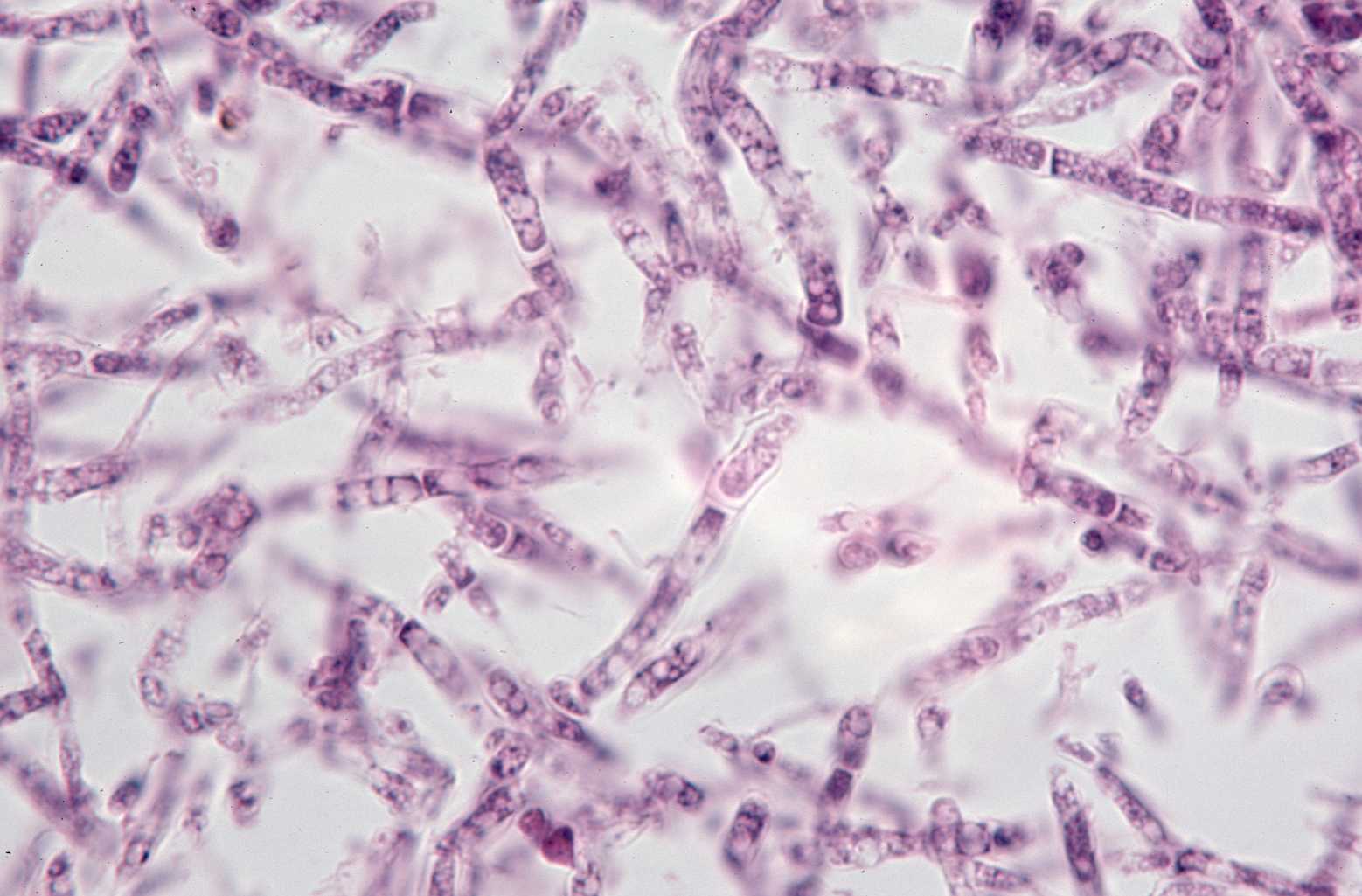
Emerging Research and Future Directions in Candida Management
The field of Candida research is continuously evolving, with scientists exploring new avenues for prevention, diagnosis, and treatment. Some promising areas of study include:
1. Novel Antifungal Agents
Researchers are investigating new classes of antifungal drugs that may be more effective against resistant strains of Candida. These include drugs that target specific pathways in fungal cell walls or membranes, potentially offering more targeted treatment options with fewer side effects.
2. Microbiome Modulation
Understanding the role of the human microbiome in preventing Candida overgrowth is opening up new possibilities for prevention and treatment. Probiotics and prebiotics are being studied for their potential to maintain a healthy balance of microorganisms and prevent Candida infections.
3. Immunotherapy Approaches
Researchers are exploring ways to enhance the immune system’s ability to recognize and combat Candida infections. This includes developing vaccines and immunomodulatory therapies that could help prevent or treat recurrent infections.

4. Biofilm Disruption Strategies
Candida’s ability to form biofilms (communities of microorganisms that adhere to surfaces) contributes to its persistence and resistance to treatment. Scientists are investigating methods to disrupt these biofilms, potentially making infections more susceptible to antifungal therapies.
5. Rapid Diagnostic Tools
Developing faster and more accurate diagnostic methods is crucial for timely and effective treatment. Researchers are working on molecular-based tests and point-of-care diagnostics that could provide quicker results and help guide treatment decisions.
When to Seek Medical Attention for Candida Infections
While some mild Candida infections may resolve on their own or with over-the-counter treatments, there are situations where medical attention is necessary. Consider seeking healthcare if:
- Symptoms persist or worsen despite home treatment
- You experience recurrent infections (more than four in a year)
- You have diabetes or a weakened immune system
- You’re pregnant
- You develop a fever or other signs of a more serious infection
- You’re unsure if your symptoms are caused by a Candida infection
Early intervention can prevent complications and ensure appropriate treatment, especially for individuals with underlying health conditions or compromised immune systems.

Living with Chronic Candida: Management and Coping Strategies
For some individuals, Candida infections may become a chronic or recurrent issue. Managing this condition often requires a multifaceted approach:
Lifestyle Modifications
- Adopting a low-sugar, anti-inflammatory diet
- Practicing stress-reduction techniques like meditation or yoga
- Ensuring adequate sleep and exercise
- Avoiding potential triggers (e.g., certain foods, tight clothing)
Long-term Medical Management
Working closely with healthcare providers, individuals with chronic Candida may benefit from:
- Prophylactic antifungal treatments
- Regular check-ups to monitor for complications
- Management of underlying conditions that may contribute to recurrent infections
Support and Education
Living with chronic Candida can be challenging. Support groups, patient education programs, and counseling can provide valuable resources for coping with the emotional and social aspects of the condition.
By understanding the nature of Candida infections, their impact, and the latest developments in treatment and management, individuals can take proactive steps to maintain their health and quality of life. As research continues to advance, there is hope for more effective strategies to prevent and manage Candida overgrowth, offering relief to those affected by these common yet troublesome infections.

Candida albicans: Infections, symptoms, and treatments
Candida albicans is part of our natural microflora — or the microorganisms that commonly live in or on our bodies. It can be found in the GI tract, the mouth, and the vagina.
Most of the time it causes no issues, but it’s possible for overgrowths and infections to happen.
Candida albicans is the most prevalent cause of fungal infections in people. Its species name, albicans, comes from the Latin word for “white.” The yeast appears white when cultured on a plate. And in the case of certain infections, like thrush, it can create white patches.
We look more closely at types of Candida albicans infections and how they’re treated.
Below, we’ll explore the causes, symptoms, and treatment of four of the most common types of Candida infection. In the next section we’ll go over the less common infections that Candida albicans can also cause.
Urinary yeast infection
Candida species are the most common cause of fungal urinary tract infections (UTIs). Candida UTIs can occur in the lower portion of the urinary tract or in some cases can ascend up to the kidneys.
Candida UTIs can occur in the lower portion of the urinary tract or in some cases can ascend up to the kidneys.
The following can put you at risk of developing a Candida UTI:
- having taken a course of antibiotics
- having a medical device inserted, such as a urinary catheter
- diabetes
- a weakened immune system
Symptoms
Many people with a Candida UTI don’t have symptoms. If symptoms are present, they can include:
- an increased need to urinate
- a painful or burning sensation when urinating
- abdominal or pelvic pain
- blood in your urine
Treatment
Treatment is only recommended for symptomatic individuals. The antifungal drug fluconazole can be used in many cases.
If a catheter is in place, it should be removed.
Genital yeast infection
Candida albicans is the most common cause of genital yeast infections.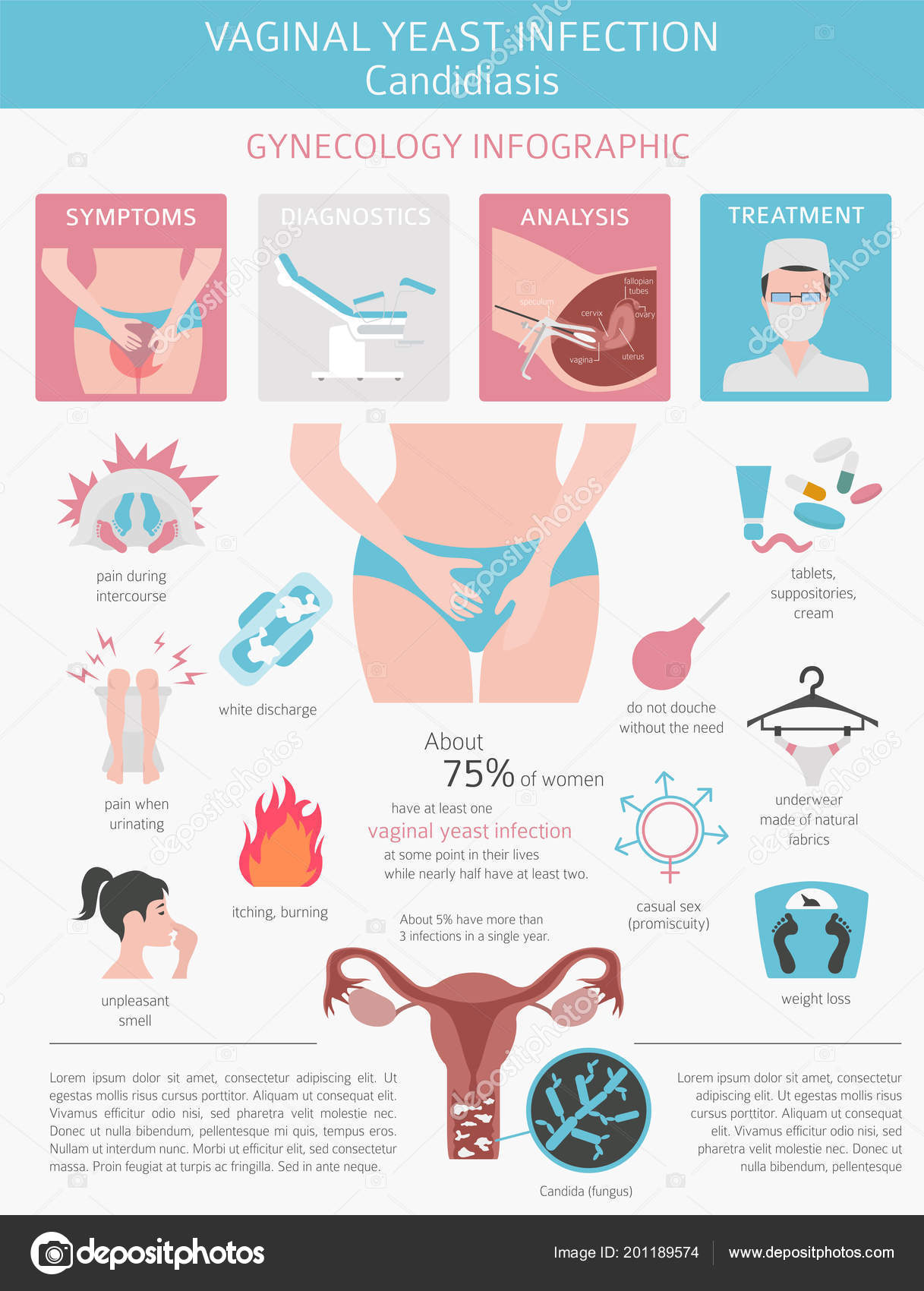
Normally, a type of bacteria called Lactobacillus keeps the amount of Candida in the genital area under control. However, when Lactobacillus levels are disrupted in some way, Candida can overgrow and cause an infection.
You can also develop a Candida genital infection after participating in certain sexual activities, particularly those that involve oral-genital contact.
Although otherwise healthy individuals can get genital Candida infections, the following groups are at an increased risk:
- people that have taken antibiotics recently
- people with uncontrolled diabetes
- immunosuppressed individuals
- pregnant women
- people that are taking oral contraceptives or who are on hormone therapy
Symptoms
Symptoms of a genital Candida infection can include:
- a burning feeling while having sex or while urinating
- an itchy or painful feeling in or around the vagina
- redness, irritation, or swelling around the vagina
- abnormal vaginal discharge that can be either watery, or thick and white
- a rash around the vagina
- a rash on the penis
Candida species can also infect the male genitals, often if their partner has a vaginal Candida infection.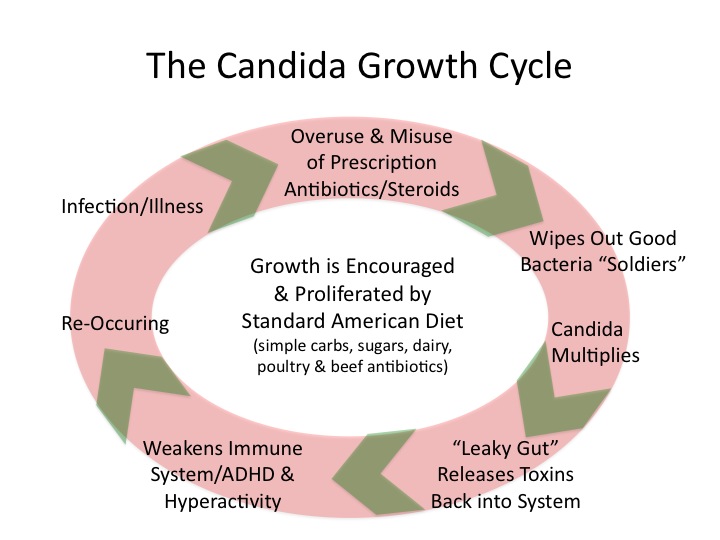 The infection may be asymptomatic, but can cause an itchy or burning rash around the head of the penis.
The infection may be asymptomatic, but can cause an itchy or burning rash around the head of the penis.
Treatment
Mild or moderate genital Candida infections can be treated with a short course of an over-the-counter (OTC) or prescription antifungal cream, pill, or suppository. You could also be prescribed a single dose of an oral antifungal medication, such as fluconazole.
For more complicated infections, you may be prescribed a longer course of medication, either in the form of a cream, a pill, or an ointment.
Oral thrush
Despite being a normal part of the microflora of your mouth, Candida albicans can cause infections if it overgrows. The infection may not be limited to just your mouth. It can spread to your tonsils and the back of your throat as well.
Severe infections may spread to the esophagus.
People that are at an increased risk for developing oral thrush include:
- those taking antibiotics or corticosteroid drugs
- someone with undiagnosed or uncontrolled diabetes
- immunosuppressed individuals
- those who wear dentures, particularly upper dentures
Symptoms
Some of the common symptoms of oral thrush include:
- white spots in your mouth that have the appearance of cottage cheese and may bleed when touched
- a burning or painful sensation in your mouth
- redness inside your mouth or at the corners of your mouth
- difficulty with eating or swallowing
- loss of taste
- a cotton-like feeling inside your mouth
If an oral thrush infection is left untreated, it can lead to a systemic Candida infection, particularly in people with a weakened immune system.
Treatment
Oral thrush is treated with an antifungal medication that can come in the form of a pill, liquid, or lozenge. Examples of drugs that are used include nystatin or clotrimazole.
An oral course of fluconazole can be given for more severe cases.
Mucocutaneous candidiasis
Candida species can also infect your skin and mucus membranes.
Candida albicans is most often the cause of a fungal skin infection, although other Candida strains can also cause it.
Areas that are warm, moist, or sweaty provide good environments for yeast to thrive. Examples of such areas include the armpits, groin, the skin between your fingers and toes, the corners of your mouth, and the area under your breasts.
Other risk factors for developing a Candida skin infection include:
- wearing tight or synthetic undergarments
- having poor hygiene or changing undergarments infrequently, including infrequent diaper changes for infants
- taking antibiotics or corticosteroid drugs
- having diabetes
- having a weakened immune system
Symptoms
The most common symptom of a Candida skin infection is a red rash that forms in the affected area.
In some cases, blister-like lesions can form. The skin may also become thickened or produce a white substance that has a curd-like appearance.
Treatment
Antifungal creams are typically given to clear the skin infection. They can contain antifungal drugs such as clotrimazole, miconazole, and econazole.
A steroid cream may also be given to help ease any itching or swelling. The skin should also be kept dry while recovering.
In cases where the infection is widespread, oral fluconazole pills may be prescribed.
In order to diagnose candidiasis, your doctor will first take your medical history and ask you about your symptoms. They may also ask if you have any conditions or medications that could lead to a weakened immune system, or if you’ve taken a course of antibiotics recently.
Many common cases of candidiasis can often be diagnosed through a physical examination.
If your doctor is uncertain if your symptoms are due to a Candida infection, they may take a sample from the affected area. This sample can then be used to culture the organism and to identify what species it is. For example, if candidemia is suspected, your doctor will collect a blood sample for testing.
This sample can then be used to culture the organism and to identify what species it is. For example, if candidemia is suspected, your doctor will collect a blood sample for testing.
Identifying the species of Candida that’s causing your infection is also helpful because your doctor will be able to prescribe an antifungal medication that will be effective in treating that particular species.
If Candida albicans enter your bloodstream, they can cause serious infections not only in your blood but in other organs as well.
Neutropenia — a key risk factor
An important risk factor for developing more invasive Candida conditions is neutropenia. This is when there are abnormally low levels of cells called neutrophils in your blood. It can make you more prone to infections.
People that are commonly affected by neutropenia include people undergoing chemotherapy or radiation therapy for cancer, and people with leukemia or other bone marrow diseases.
Individuals that have neutropenia and an invasive Candida infection have different treatment recommendations.
Candidemia
Candidemia is a blood infection with Candida species. It can lead to long hospital stays and an increase in mortality due to concurrent conditions.
Risk factors for candidemia include:
- immunosuppression
- use of broad-spectrum antibiotics
- major surgery
- placement of a medical device such as a feeding tube or catheter
Symptoms
Symptoms can resemble those of bacterial sepsis and can include:
- fever
- kidney failure
- shock
Diagnosis and treatment
Candidemia can be diagnosed when the yeast is isolated from a blood sample.
Treatment may depend on the species of Candida causing the infection, but can include IV doses of fluconazole, caspofungin, micafungin, or amphotericin B. Catheters should also be removed.
Endocarditis
Endocarditis is an infection of the inner lining of your heart, which includes the heart chambers and valves.
Fungal endocarditis is a very serious condition with a high mortality rate. Candida albicans is responsible for 24 to 46 percent of all cases of fungal endocarditis.
Risk factors for developing this condition include:
- a weakened immune system
- heart abnormalities or defects
- prolonged antibiotic use
- cardiovascular surgery
- implantation of medical devices, such as a feeding tube, catheter, or prosthetic heart valves
Symptoms
Symptoms of fungal endocarditis can include:
- fever
- cough
- difficulty breathing
- generalized body pain, sometimes in the lower extremities
Diagnosis and treatment
Diagnosis can be difficult because symptoms are often similar to endocarditis caused by bacteria.
Treatment may include intravenous (IV) fluconazole or amphotericin B, removal of any infected medical device, and possible surgical removal of fungus from the tissue.
Endophthalmitis
Endophthalmitis is an inflammation of the eye that can be caused by fungus. It can lead to loss of vision.
Candida albicans is the most common Candida species involved, although Candida tropicalis can also cause the infection.
Risk factors for endophthalmitis are:
- recent hospitalization
- recent surgery
- a weakened immune system
- having a medical device such as a catheter or IV inserted
Symptoms
The condition can affect one or both eyes. The main symptom is inflammation in the eye, although in some cases pus can be present in the tissues of the eye.
Diagnosis and treatment
Endophthalmitis can be diagnosed through a retinal examination as well as by analyzing a sample of fluid from your eye.
Treatment can include amphotericin B with flucytosine. Fluconazole can also be used.
Meningitis
Meningitis is the inflammation of the tissues that surround your brain and spinal cord.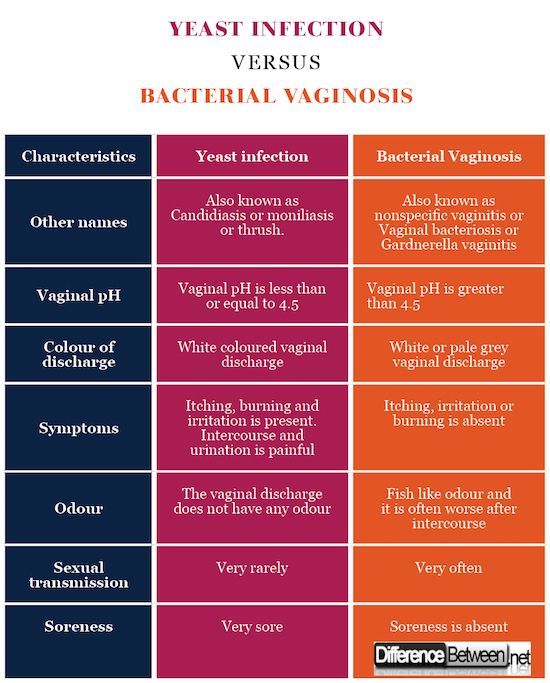 Fungal meningitis can occur when fungus travels through the blood to your spinal cord. Fungal meningitis caused by Candida is often acquired within a hospital.
Fungal meningitis can occur when fungus travels through the blood to your spinal cord. Fungal meningitis caused by Candida is often acquired within a hospital.
Factors that can put you at risk for meningitis caused by Candida can include:
- immunosuppression
- certain medications such as antibiotics, immunosuppressants, or corticosteroids
- a recent surgical procedure
Symptoms
Symptoms of fungal meningitis include:
- headache
- stiff neck
- fever
- nausea and vomiting
- sensitivity to light
- confusion
Diagnosis and treatment
If a fungus is suspected for causing your meningitis, a sample of cerebral spinal fluid (CSF) will be taken and cultured.
The recommended treatment of meningitis caused by Candida species is amphotericin B with flucytosine.
Intra-abdominal candidiasis
Intra-abdominal candidiasis can also be referred to as Candida peritonitis. It’s an inflammation of the lining of your inner abdomen caused by a yeast infection.
It’s an inflammation of the lining of your inner abdomen caused by a yeast infection.
The condition is most commonly caused by Candida albicans although other Candida species can cause it as well.
Some risk factors for developing intra-abdominal candidiasis include:
- a recent abdominal surgery or procedure
- undergoing peritoneal dialysis
- antibiotic therapy
- conditions such as diabetes
Symptoms
The symptoms of intra-abdominal candidiasis can be very similar, if not indistinguishable, from bacterial peritonitis. Symptoms can include:
- pain or bloating in your abdomen
- fever
- nausea and vomiting
- feeling tired or fatigued
- diarrhea
- diminished appetite
In order to diagnose the condition, your doctor will take a sample of abdominal fluid (peritoneal fluid). If Candida is causing the infection, yeast will be observed in the sample.
Treatment
Treatment can include antifungal drugs such as:
- fluconazole
- amphotericin B
- caspofungin
- micafungin
Catheters should be removed as well.
Osteomyelitis and fungal arthritis
Osteomyelitis is a bone infection while fungal arthritis (also called septic arthritis) is a fungal infection of a joint. Both conditions can be caused by Candida species, although this is rare. Bacterial infections are more common.
Risk factors for developing these conditions can include:
- having a weakened immune system
- experiencing a recent bone injury or orthopedic procedure
- having an IV or a catheter
- conditions such as diabetes
Symptoms
Symptoms of these conditions include pain or swelling in the affected area that can be accompanied by fever or chills. People with fungal arthritis can also have great difficulty using the affected joint.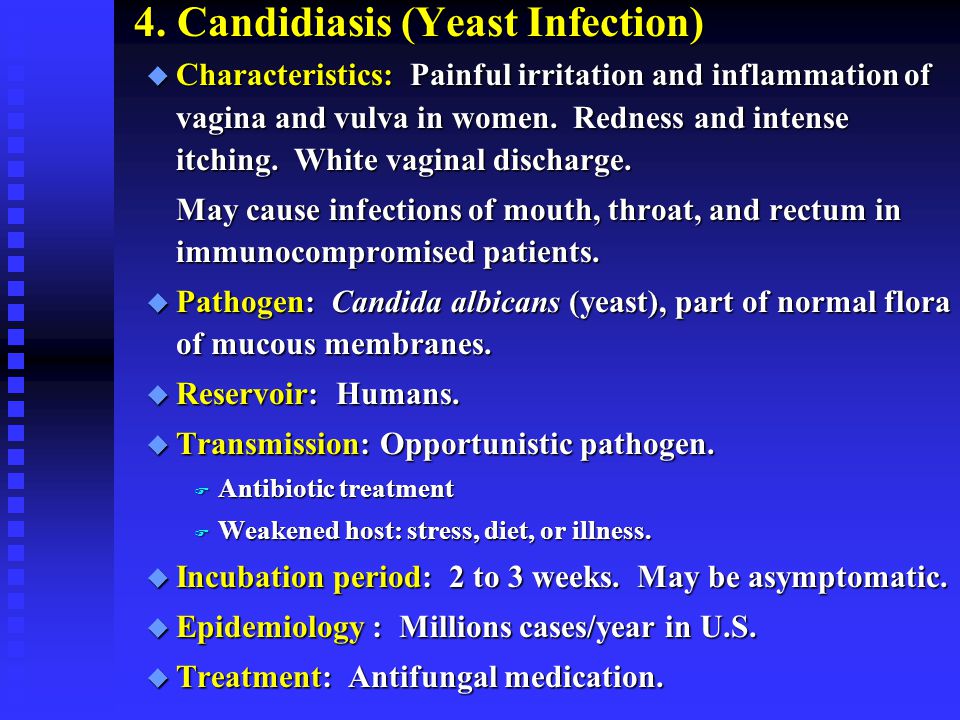
In order to determine if a fungal infection is causing osteomyelitis, a bone biopsy may be needed. Analysis of joint fluid can determine if arthritis is due to a fungal infection.
If a blood infection caused either condition, Candida may also be detected in the blood.
Treatment
Treatment can include courses of antifungal medication such as amphotericin B and fluconazole.
Normally, Candida species are a part of the natural microflora of the GI tract, skin, and vagina, and don’t cause disease. Some circumstances, such as taking a long course of antibiotics or having a weakened immune system can increase your risk of developing a Candida infection.
The most common Candida infections, such as vaginal and skin infections, are localized and can be treated with antifungal drugs. An untreated Candida infection carries the risk of leading to a systemic infection in which other organs can become involved.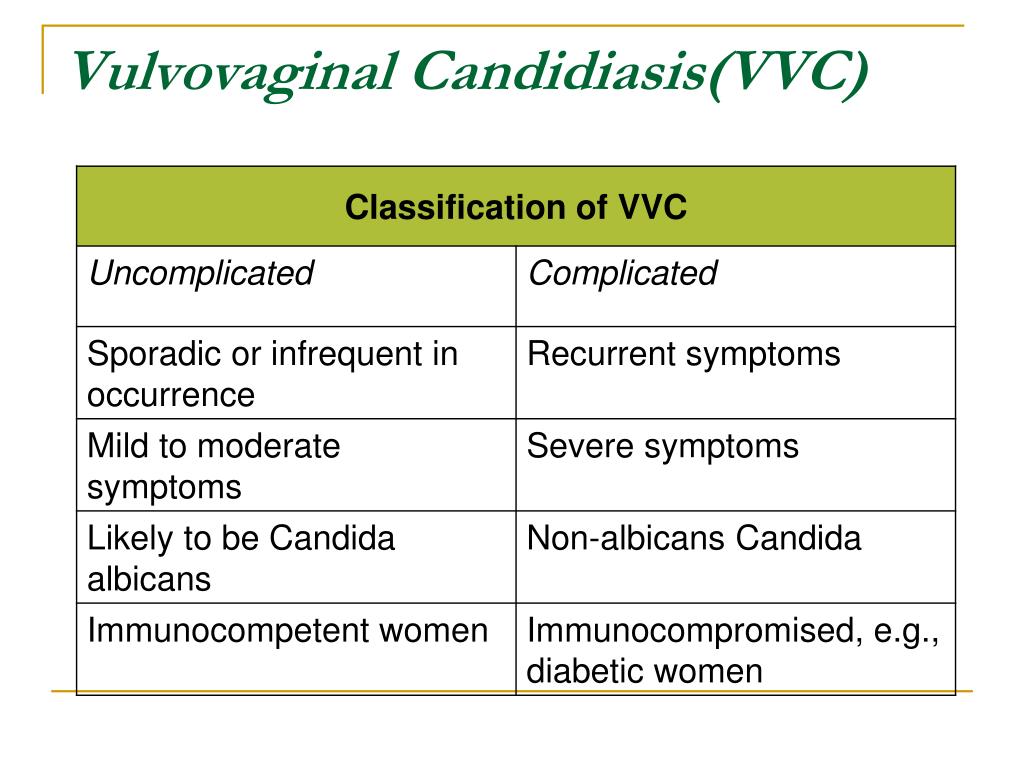
If you notice symptoms that are consistent with those of a Candida infection, see your doctor in order to receive the proper diagnosis and treatment.
Candida Infections in Birds | VCA Animal Hospitals
What is
Candida?
Candida albicans is a common environmental yeast that can infect the digestive tracts of birds. It is a common cause of ‘sour crop’ or a crop infection, scientifically referred to as ingluvitis. Candida is more common in young birds. It may be spread from an adult bird feeding a young one, from being housed in a contaminated environment, drinking contaminated water, or eating contaminated hand-feeding formulas.
“It is a common cause of ‘sour crop’ or a crop infection, scientifically referred to as ingluvitis.”
People with yeast infections in their mouths (thrush) have Candida. Candida can be a primary or secondary cause of crop infections. Candida, in small numbers, is usually considered a normal resident of a bird’s oral cavity and digestive tract. A disruption or imbalance of normal bacterial populations in the digestive tract may lead to a secondary overgrowth of Candida. Excessive sugar or carbohydrates in the diet may contribute to Candida overgrowth, as yeast and fungal organisms grow well in high-sugar environments.
A disruption or imbalance of normal bacterial populations in the digestive tract may lead to a secondary overgrowth of Candida. Excessive sugar or carbohydrates in the diet may contribute to Candida overgrowth, as yeast and fungal organisms grow well in high-sugar environments.
Often, other diseases compromise a bird’s immune system and predispose the bird to secondary Candida infection (candidiasis). Steroid use, long-term antibiotic use, excessive stress, poor husbandry and hygiene, viral infections, and other chronic infections can all cause immune suppression and lead to secondary candidiasis.
In its advanced stages, Candida can affect a bird systemically, as it goes outside the gastrointestinal tract and invades the rest of the body; this is rare. With a systemic infection, it can be found in the blood, certain body organs, and bone marrow.
How do I know if my bird is infected with
Candida?
Common clinical signs include lethargy, fluffed feathers, little to no appetite, vomiting or regurgitation, delayed crop emptying, a distended crop full of mucus, and occasionally a crop impacted with dry food, mucus, or other debris.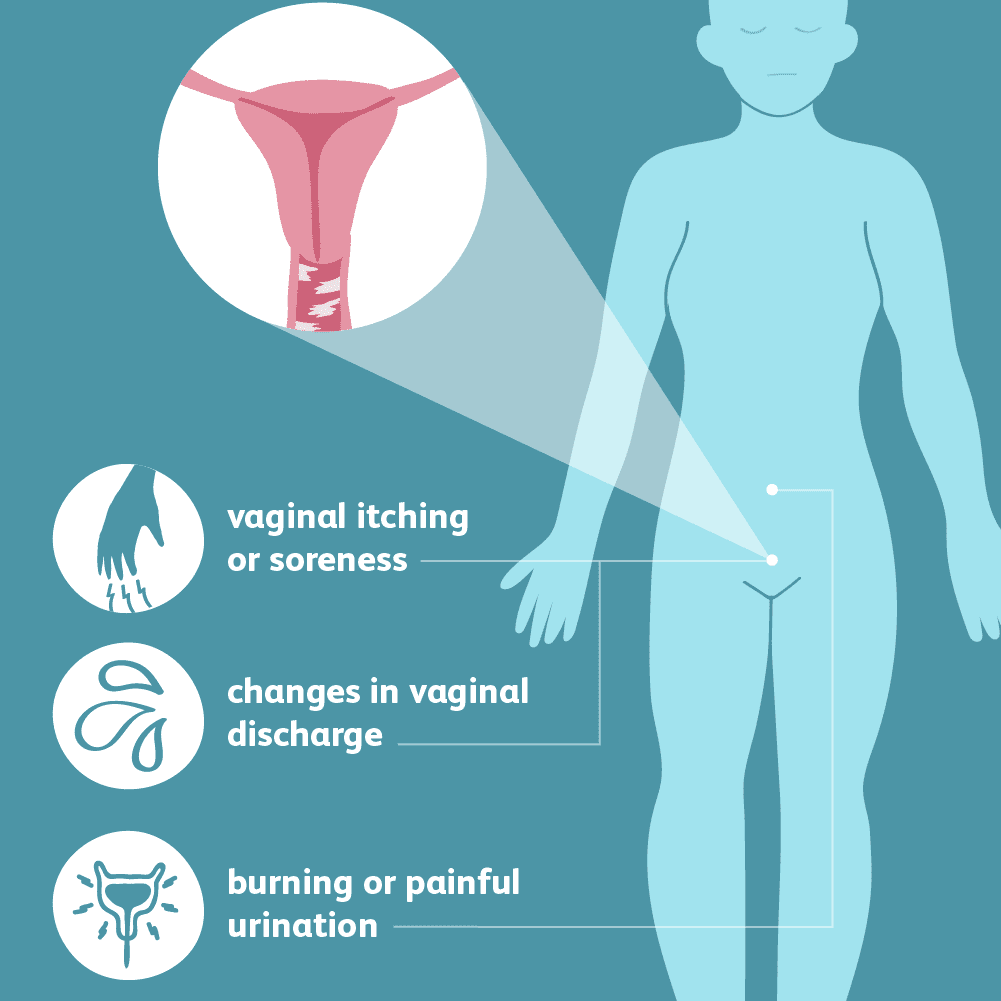 Your avian veterinarian will start with a complete history, body weight, and physical examination. Since the clinical signs of candidiasis occur with many other diseases and are not specific to candidiasis, your veterinarian will likely advise a series of diagnostic tests to determine the exact cause of the disease.
Your avian veterinarian will start with a complete history, body weight, and physical examination. Since the clinical signs of candidiasis occur with many other diseases and are not specific to candidiasis, your veterinarian will likely advise a series of diagnostic tests to determine the exact cause of the disease.
How is candidiasis diagnosed?
Candidiasis is diagnosed by fungal culture and/or cytology (microscopic analysis) of fluid from either the crop or feces. A Gram’s stain is used to stain the fluid from the crop or fecal material to identify the organisms on a microscope slide. Since Brewer’s yeast may be added to hand-feeding formulas and may be present in many baked goods, specific fungal culturing is recommended for differentiation, as Brewer’s yeast and Candida can look similar under the microscope. If your bird had eaten baked goods or other yeast-containing foods during the day before the sample was taken and she is not severely ill, your veterinarian might suggest withholding all yeast-containing foods for a few days before rechecking a sample under the microscope. Severely affected birds should be treated regardless of whether they’ve eaten yeast-containing products.
Severely affected birds should be treated regardless of whether they’ve eaten yeast-containing products.
“Severely affected birds should be treated regardless of whether they’ve eaten yeast-containing products.”
The quality of the sample is essential. If a sample does not demonstrate yeast, especially if your bird is sick, it may be that she is not suffering from a Candida infection but some other illness. Further testing will be necessary to pinpoint the disease that is causing her illness.
It is common for candidiasis to develop secondary to other disease processes, so it will be necessary for other tests to be performed to determine whether there are other problems predisposing your bird to secondary infection. Early diagnosis generally leads to faster resolution of underlying problems.
Can my bird be treated?
Yes, once diagnosed, Candida is treated with antifungal medications. There are several medications available. In addition to treating candidiasis, your veterinarian should diagnose and treat all predisposing factors or diseases.
In addition to treating candidiasis, your veterinarian should diagnose and treat all predisposing factors or diseases.
Good hygiene, a clean environment, and fresh food and water are essential in managing this problem and maintaining your bird’s health. Correcting dietary imbalances will also aid in your bird’s recovery.
If your bird is diagnosed with candidiasis, follow your veterinarian’s recommendations in administering prescribed medications and ensuring your pet’s environment is adequately disinfected.
Candidal infections in surgical practice | Klyasova G.A.
In over the past 10-15 years there has been a clear trend towards an increase in the number of mycotic infections. Thus, yeasts and molds are among the ten most frequently identified nosocomial pathogens; in intensive care units, they are ranked fifth, reaching 17%; among bloodstream infections Candida spp . occupy the 4th place, accounting for 7.6%; approximately 7% of cases of fevers of unknown etiology in patients treated in a hospital are due to fungi [1,2]. Moreover, these microorganisms are problematic not only in oncohematological patients. Thus, the analysis of 837 cases of candidemia showed that most often they occurred in patients with malignant tumors (26%) and after surgical treatment (18.5%). At the same time, among surgical patients, the highest frequency was registered in abdominal surgery, amounting to 13.5% (number of patients 113) [3]. The incidence of candidemia in cardiothoracic surgery was 4.3%, in general surgery departments – 1.7% [3]. Fungal infections are not uncommon complications in patients with burns and after injuries.
Moreover, these microorganisms are problematic not only in oncohematological patients. Thus, the analysis of 837 cases of candidemia showed that most often they occurred in patients with malignant tumors (26%) and after surgical treatment (18.5%). At the same time, among surgical patients, the highest frequency was registered in abdominal surgery, amounting to 13.5% (number of patients 113) [3]. The incidence of candidemia in cardiothoracic surgery was 4.3%, in general surgery departments – 1.7% [3]. Fungal infections are not uncommon complications in patients with burns and after injuries.
Most often, the mycotic process is caused by fungi Candida spp ., which account for up to 80% of all nosocomial fungal infections.
Epidemiology of invasive candidiasis . Of the yeasts, the most common pathogens are Candida albicans . However, there is a tendency to reduce the frequency of their isolation from 80–90% (70–80s) to 40–60% (90s). Since the 90s, the isolation of Candida non-albicans has been increasing: C. tropicalis, C. krusei, C. glabrata, C. kefyr, C. parapsilosis and others [1]. The share of infections caused by C. glabrata accounts for 5 to 35%, C. tropicalis – from 8 to 43%. C. lusitaniae, C. dubliniensis, C. guilliermondii are rare pathogens.
tropicalis, C. krusei, C. glabrata, C. kefyr, C. parapsilosis and others [1]. The share of infections caused by C. glabrata accounts for 5 to 35%, C. tropicalis – from 8 to 43%. C. lusitaniae, C. dubliniensis, C. guilliermondii are rare pathogens.
Risk factors in the development of invasive candidiasis . The factors that determine the occurrence of invasive candidiasis in surgical patients differ from the factors that induce fungal infections in patients of a different category. The main factors include abdominal operations, especially repeated ones, which account for 75% of all cases of fungal infections. Another equally important factor is age (approximately 50% of mycoses in surgical practice are recorded in patients older than 60 years). The likelihood of developing candidemia is significantly higher if infectious complications are treated with three or more antibiotics [4]. Multivariate analysis showed that colonization of Candida spp. . many loci (eg, oral cavity, intestines, vagina), previous hemodialysis, parenteral nutrition, the presence of a central venous catheter, especially a three-way one, are also significant factors influencing the occurrence of invasive candidiasis [5]. Invasive candidiasis is recorded more often in patients with extensive burns, with a urinary catheter, receiving antacids, H 2 blockers or other drugs that suppress the acidity of gastric juice, glucocorticoid drugs, long-term use of antibacterial drugs.
. many loci (eg, oral cavity, intestines, vagina), previous hemodialysis, parenteral nutrition, the presence of a central venous catheter, especially a three-way one, are also significant factors influencing the occurrence of invasive candidiasis [5]. Invasive candidiasis is recorded more often in patients with extensive burns, with a urinary catheter, receiving antacids, H 2 blockers or other drugs that suppress the acidity of gastric juice, glucocorticoid drugs, long-term use of antibacterial drugs.
Pathogenesis . Candidiasis is primarily an endogenous infection. Candida can colonize the skin, oropharyngeal mucosa, and intestines, and their translocation occurs through the intestinal epithelium [6]. With such a variant of dissemination, through the intestines, invasion by candida occurs, primarily of the liver, spleen, and lungs. Other entry gates for candida are venous catheters [6]. Infection of catheters occurs from the patient’s skin or through the hands of medical staff. In this case, the dissemination pathways of fungi target organs are, as a rule, the kidneys, heart, lungs. The circulation of candida in the blood passes for a short time, then, damaging the endothelium, they penetrate into the organs, leading to the formation of small abscesses.
In this case, the dissemination pathways of fungi target organs are, as a rule, the kidneys, heart, lungs. The circulation of candida in the blood passes for a short time, then, damaging the endothelium, they penetrate into the organs, leading to the formation of small abscesses.
Invasive candidiasis
Candidemia – fungus isolation Candida spp . at least one blood culture is always taken into account and is the basis (in the presence of symptoms of infection) for adequate antimycotic therapy. It should be noted that in some patients, the detection of Candida spp . may not show up clinically in the blood. A similar course of infection occurs in patients with uremia treated with glucocorticoid agents.
Acute disseminated candidiasis is an invasion of one or more organs by candida through the hematogenous route. Yeast fungi can affect any organ, but most often the liver, kidneys, spleen, heart, organs of vision, lungs, brain, skin and subcutaneous tissue are involved in the process. In these cases, fungi can only be detected by cultivation and/or histological examination of organ biopsy specimens.
In these cases, fungi can only be detected by cultivation and/or histological examination of organ biopsy specimens.
Clinical symptoms of candidemia or acute disseminated candidiasis are not specific. The most common symptom is fever, which persists or recurs during broad-spectrum antibiotic therapy. In 10–15% of cases, skin lesions (screenings) are noted in the form of discrete, small, 0.3–0.6 cm in size papular formations of a pinkish-reddish color or subcutaneous abscesses. Another symptom characteristic of invasive candidiasis (candidal sepsis) is quite pronounced muscle pain that disturbs patients at rest – it is rarely recorded. Endophthalmitis with candidemia occurs in 9-15% of patients. Clinical symptoms include a decrease in visual acuity up to the development of blindness, whitish plaques are detected on the fundus. In all patients with candidemia, ophthalmoscopy with pupillary dilation should be performed [7].
Mortality in candidemia remains high, amounting to 40% .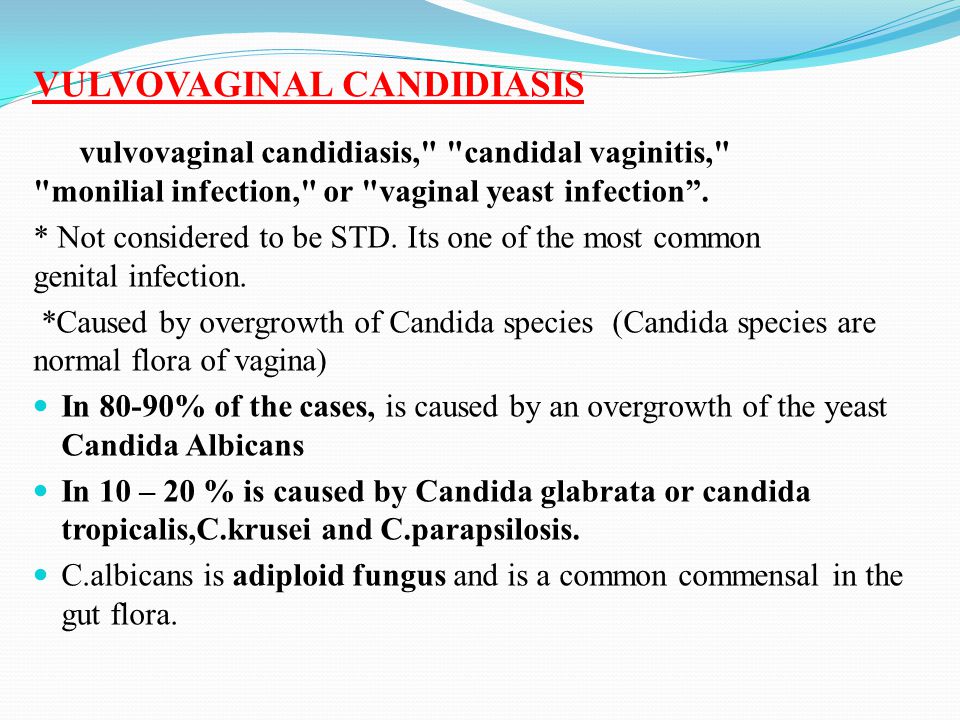 The minimum frequency of deaths is recorded in infections caused by C. parapsilosis (7-8%), the maximum – in infections caused by C. glabrata (45%). In acute disseminated candidiasis, 70–80% of patients die.
The minimum frequency of deaths is recorded in infections caused by C. parapsilosis (7-8%), the maximum – in infections caused by C. glabrata (45%). In acute disseminated candidiasis, 70–80% of patients die.
Candida damage to the lungs occurs mainly due to hematogenous dissemination of fungi, extremely rarely being the primary manifestation of the candidal process (aspiration of candida from the pharynx). Diagnosis of pneumocandidiasis is difficult. On radiographs, there is a decrease in the transparency of the lung tissue, it gives the impression of the presence of small multiple foci. In these cases, computed tomography of the lungs is necessary. Pneumocandidiasis is characterized by the presence of small multiple foci located along the periphery of the lung fields. Clinical symptoms are nonspecific, sometimes a dry cough may bother.
Invasion of the central nervous system by yeast fungi occurs in the form of damage to the membranes, substance and vessels of the brain, often complicating the treatment process in patients with ventriculo-peritoneal shunts. Clinically manifested by meningitis, encephalitis, brain abscesses, mycotic aneurysm.
Clinically manifested by meningitis, encephalitis, brain abscesses, mycotic aneurysm.
Candidal endocarditis occurs more often in patients who have undergone prosthetic heart valves or have previously had damage (vegetation) on the heart valves of a different infectious nature. Predisposing factors in the development of this pathology are central venous catheterization, intravenous administration of narcotic drugs (in drug addicts). With candidal endocarditis, the aortic valve is most often involved, in 40% of cases, then the mitral valve, less often the tricuspid valve, in drug addicts the tricuspid valve is most often involved. The clinical picture of candidal and bacterial endocarditis is similar. For candidal endocarditis, only a high frequency of embolism is characteristic. Embolism of the coronary arteries by fungi leads to the development of ischemia or myocardial infarction. In 60% of patients, the diagnosis of endocarditis is established only at autopsy. Approximately 80% of patients with endocarditis have a positive growth of candida in blood cultures.
Candida lesions of the joints are observed with hematogenous dissemination of infection or with intra-articular administration of glucocorticoids. Such infection occurs primarily in patients with rheumatoid arthritis and in patients with foreign intra-articular devices. The knee joint is more often affected, signs of general inflammation are often absent, the infectious process in most cases is manifested by local symptoms. The diagnosis is based on the isolation of fungi (crops) from the periarticular fluid. Timely diagnosis, surgical treatment (detritus removal, drainage) and antimycotic therapy can prevent the development of cartilage tissue destruction.
Most cases of candidal osteomyelitis, with the exception of cases of fungal infection of the sternum that occur during its operational dissection (sternotomy), are the result of hematogenous spread of infection. Often, the vertebrae are involved in the infectious process. Back pain, fever, radicular syndrome occur with this pathology. The foci are drained and fluconazole is prescribed.
The foci are drained and fluconazole is prescribed.
Peritonitis and intra-abdominal abscesses
Isolation Candida spp . from peritoneal fluid obtained by aspiration or during a surgical operation in patients with intra-abdominal abscesses or peritonitis indicates intestinal perforation or is a consequence of contamination due to incompetence of the digestive tract anastomoses [8]. Candida peritonitis often occurs with tumors of the digestive tract, anastomotic leaks, intestinal perforations, urgent relaparotomy, liver cirrhosis, pancreatitis, pancreatic necrosis [6,8]. Patients with candidal peritonitis or abscesses of candidal etiology, confirmed by mycological examination (detection of fungal elements during microscopy and / or isolation of culture Candida spp .), along with surgical treatment, therapy with systemic antifungal drugs is carried out. Treatment with antibacterial drugs continues due to the polyetiology of abdominal infections. Clinical manifestations of candidal and bacterial peritonitis are identical.
Clinical manifestations of candidal and bacterial peritonitis are identical.
Candidal peritonitis may occur during ambulatory peritoneal dialysis [9,10]. In these cases, the infectious process is local, manifested by low fever and pain or discomfort in the abdomen. At the same time, the peritoneal dialysate is opaque and contains more than 100 neutrophils per 1 mm 3 . Treatment includes removal of the peritoneal catheter and administration of systemic antimycotics. Abdominal pain may occur when amphotericin B is added to the dialysate because the drug can cause chemical peritonitis. The concentration of fluconazole in the peritoneal fluid is high, this antimycotic is the drug of choice in the treatment of these complications .
Candida can cause cholangitis, abscesses in the pancreas and liver [7]. Such complications occur primarily in patients with drainage in the abdominal cavity, after surgery for tumors of the digestive tract.
Wound infection
Diagnosis and treatment of candidal wound infection is very problematic. Isolation of Candida spp . from a drain or from a wound is not strong evidence of a candidal wound infection. Candida spp. . can only colonize the wound without leading to an invasive process [11]. However, in cases where wound infection persists or progresses with antibiotic therapy, especially in cases of re-isolation of Candida spp. . from the wound, it is recommended to use systemic antifungal drugs [12].
It should be noted the need to prescribe systemic antifungal drugs in all cases of isolation of Candida spp . from a postoperative wound on the sternum used as an operative access for heart surgery, due to the risk of developing osteomyelitis.
Empiric and preventive therapy
Candida spp. . are pathogens that are often detected from non-sterile loci in intra-abdominal infections. Therapy with systemic antimycotics should be carried out in patients at high risk of developing invasive candidiasis. This group consists of patients who have Candida colonization of several loci. For a long time they are in intensive care, where they are treated with antibiotics, a central venous catheter is placed, and parenteral nutrition is provided [12]. If there is no colonization of mucous membranes by Candida, then patients are at low risk of invasive candidiasis, and the appointment of systemic antimycotics should be postponed [12].
Therapy with systemic antimycotics should be carried out in patients at high risk of developing invasive candidiasis. This group consists of patients who have Candida colonization of several loci. For a long time they are in intensive care, where they are treated with antibiotics, a central venous catheter is placed, and parenteral nutrition is provided [12]. If there is no colonization of mucous membranes by Candida, then patients are at low risk of invasive candidiasis, and the appointment of systemic antimycotics should be postponed [12].
Burn patients
The frequency of hematogenous candidiasis in this category of patients is 2-14%. Colonization by yeast fungi, the frequency of hematogenous dissemination, lethality in Candida infection correlate with the extent and intensity of the burn. The principles of treatment of candidiasis in patients with burns are identical to those used in surgical practice.
Diagnostics
Diagnosis of invasive candidiasis is based on the detection of yeast cells (fungi of the genus Candida can form pseudomycelium or true mycelium) in biopsy specimens or aspirates, with the exception of mucous membranes or culture isolation from samples obtained under aseptic conditions from a normally sterile focus (blood, abscess contents, peritoneal fluid, aspirates) [11,12].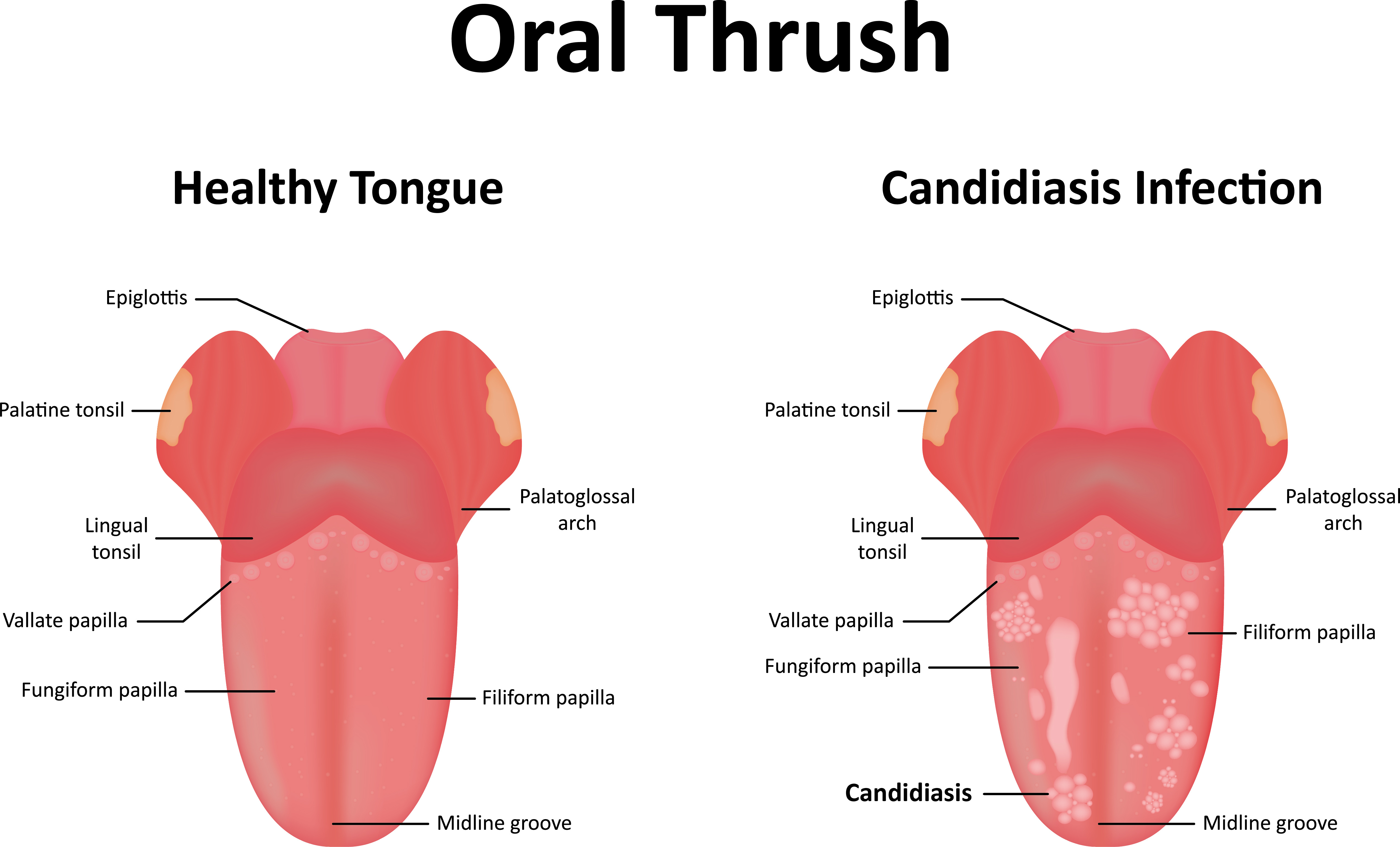 Isolation of yeast fungi from mucous membranes, from the surface of wounds indicates colonization by yeast fungi.
Isolation of yeast fungi from mucous membranes, from the surface of wounds indicates colonization by yeast fungi.
Treatment of invasive candidiasis
All systemic antimycotics used at the present stage are effective against candida: amphotericin B, fluconazole, itraconazole, voriconazole, caspofungin [13]. Itraconazole for oral use (in capsules or in suspension) is not prescribed as a starting therapy for invasive candidiasis, since a stable blood concentration is reached only after 1-2 weeks of taking the drug.
In invasive candidiasis, the choice of an antimycotic and its dosage are determined by the species of the isolated fungi, its sensitivity to antifungal drugs, and the patient’s clinical condition. In all cases of candidemia, the venous catheter must be removed.
Indications for prescribing fluconazole (Mikosyst) in invasive candidiasis are: the patient’s stable condition, the absence of prophylactic use of azole drugs.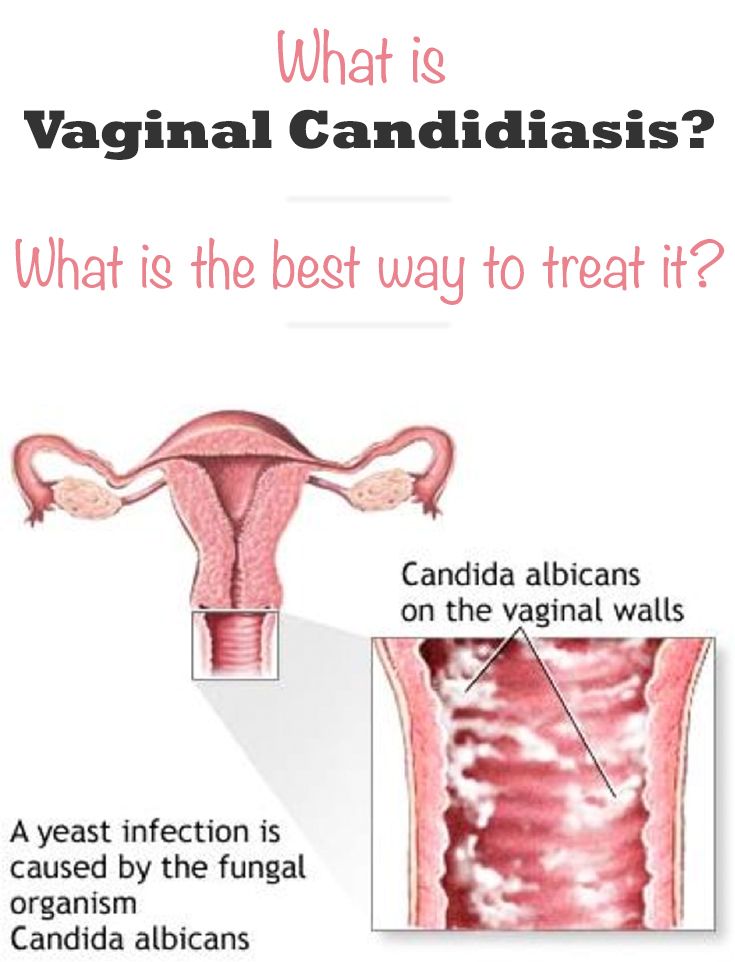 Fluconazole is prescribed 400 mg daily, once a day, intravenously or orally in capsules. When allocating C. glabrata the daily dose is doubled to 800 mg per day, the intake is the same. In two randomized trials, the efficacy of treatment of candidemia with fluconazole (400 mg/day) and amphotericin B (0.5–0.6 mg/kg/day) was comparable [14,15]. Due to low toxicity, the dosage of fluconazole can be increased to 1600 mg per day. The studies demonstrated a dose-dependent clinical effect, however, there were no significant differences in the effectiveness of therapy in the case of dose escalation. Significant toxic manifestations (convulsions, an increase in the level of biochemical blood parameters) were noted only when fluconazole was used in a daily dose of 2000 mg.
Fluconazole is prescribed 400 mg daily, once a day, intravenously or orally in capsules. When allocating C. glabrata the daily dose is doubled to 800 mg per day, the intake is the same. In two randomized trials, the efficacy of treatment of candidemia with fluconazole (400 mg/day) and amphotericin B (0.5–0.6 mg/kg/day) was comparable [14,15]. Due to low toxicity, the dosage of fluconazole can be increased to 1600 mg per day. The studies demonstrated a dose-dependent clinical effect, however, there were no significant differences in the effectiveness of therapy in the case of dose escalation. Significant toxic manifestations (convulsions, an increase in the level of biochemical blood parameters) were noted only when fluconazole was used in a daily dose of 2000 mg.
Indications for prescribing amphotericin B are an unstable condition of the patient with an unidentified species of isolated yeast fungi, invasive candidiasis caused by C. kruse i. The daily dose of amphotericin B is 0. 7-0.8 mg/kg, with the isolation of C. krusei – 1 mg/kg. After stabilization of the condition and determination of the type of pathogen, amphotericin B should be replaced with fluconazole.
7-0.8 mg/kg, with the isolation of C. krusei – 1 mg/kg. After stabilization of the condition and determination of the type of pathogen, amphotericin B should be replaced with fluconazole.
In severe conditions or when fungi resistant to fluconazole are isolated, an alternative to amphotericin B may be a liposomal form of amphotericin B or new antimycotics – voriconazole and caspofungin . Caspofungin is used only intravenously, 70 mg on the first day, followed by a maintenance dose of 50 mg daily. Voriconazole is given intravenously on the first day, 6 mg/kg every 12 hours, on subsequent days, 4 mg/kg every 12 hours; oral administration is with a patient’s body weight of more than 40 kg – 400 mg every 12 hours on the first day, then – 200 mg every 12 hours, with a body weight of less than 40 kg, the dosage is reduced by 2 times.
Indications for the appointment of the liposomal form of amphotericin B are renal failure (serum creatinine level in adults і221 µmol/l, in children – і133 µmol/l or creatinine clearance <25 ml/min), ineffectiveness of amphotericin B therapy after its use in a total dose і7 mg / kg, a significant increase in creatinine during treatment with amphotericin B, severe toxic reactions with infusion of amphotericin B. Liposomal amphotericin B is used intravenously at 3–5 mg / kg / day. [12].
Liposomal amphotericin B is used intravenously at 3–5 mg / kg / day. [12].
C. lusitaniae, C. guilliermondii are resistant to amphotericin B. The drug of choice for these pathogens is fluconazole (400 mg/day), caspofungin or voriconazole (at the previously indicated doses) may be given.
The duration of the use of antifungal drugs for candidemia and acute disseminated candidiasis should be at least 2 weeks from the last isolation of yeast fungi from the blood (or lesion), subject to complete regression of all clinical manifestations of the infection. After completion of treatment, it is recommended to observe the patient for at least 6 weeks due to the possible formation of late foci of hematogenous dissemination (endophthalmitis, osteomyelitis, chronic disseminated candidiasis).
Therapy of candidal endocarditis is complex, along with the appointment of antimycotics is mandatory surgical treatment: removal of infected heart valves. As initial therapy, it is preferable to prescribe amphotericin B at the maximum tolerated doses of 1. 0–1.5 mg/kg. The duration of the use of antimycotics after surgical treatment should be at least 6 weeks. Candidal endocarditis is characterized by a high recurrence rate, so the period of careful observation of the patient is at least 1 year. If surgical treatment is not possible, lifelong therapy with fluconazole (200–400 mg/day) [12].
0–1.5 mg/kg. The duration of the use of antimycotics after surgical treatment should be at least 6 weeks. Candidal endocarditis is characterized by a high recurrence rate, so the period of careful observation of the patient is at least 1 year. If surgical treatment is not possible, lifelong therapy with fluconazole (200–400 mg/day) [12].
Candida meningitis is treated with voriconazole (doses as for candidaemia) or amphotericin B (1 mg/kg) or liposomal amphotericin B (5 mg/kg) or fluconazole (400–800 mg) [12]. Due to the possibility of relapse, treatment should be carried out for a long time, at least 4 weeks. Antimycotics should be canceled if the cerebrospinal fluid is sterilized, all clinical manifestations of the infection are eliminated, and there is no damage to the brain substance (control MRI). It should be borne in mind that sterilization of the cerebrospinal fluid occurs before the eradication of an infectious lesion of the brain parenchyma. Therapy for candidal meningitis associated with neurosurgical treatment includes the removal of foreign material (catheters, shunts) and the appointment of antimycotics.
Prevention
A number of researchers have demonstrated the benefits of prophylactic use of fluconazole (Mikosyst) in surgical patients who are at high risk of invasive candidiasis.
In a study by Eggimann P. et al. it was shown that the prophylactic administration of fluconazole at a dose of 400 mg per day to patients with repeated abdominal operations in comparison with the control group led to a significant decrease in the incidence of candidal peritonitis (4% vs. 62%, p=0.04) [16]. Similar results were obtained by Pelz R. et al. when prescribing fluconazole to severe patients after surgery and staying in the intensive care unit for more than 3 days [17].
Thus, the prophylactic administration of fluconazole (Mikosist) (400 mg/day) is justified in patients at high risk of developing invasive candidiasis: patients with re-perforation of the gastrointestinal tract [12,7]. Unjustified prophylactic use of antimycotics in patients with a low risk of invasive candidiasis is not only useless, but also harmful, since it can be accompanied by side effects and induce the selection of Candida spp.
Candidiasis: causes, symptoms, treatment
Candidiasis (thrush) is a type of fungal infection caused by microscopic yeast-like fungi. All representatives of this genus are classified as conditionally pathogenic.
Microorganisms of the genus Candida are part of the normal microflora of the mouth, vagina and colon of most healthy people. The disease is caused not just by the presence of fungi of the genus Candida, but by their reproduction in large numbers and / or the ingress of more pathogenic strains of the fungus. Most often, candidiasis occurs with a decrease in general and local immunity.
Symptoms of candidiasis:
Burning and itching in the vulva;
white cheesy discharge from the vagina;
pain during intercourse, pain during urination.
Diagnostics
Cultural research (inoculation) should include not only the isolation and species identification of the causative agent of vaginal candidiasis, but also the determination of the sensitivity of the isolated strains to antifungal drugs.
Treatment
There are many drugs for the treatment of this disease. Some of them are applied topically (cream, vaginal tablets or suppositories), others – inside (tablets or capsules for oral administration).
Treatment of candidiasis should be comprehensive, phased, include not only getting rid of the fungus, but also the elimination of predisposing factors, and the treatment of concomitant diseases, the restoration of normal microflora.
Often the symptoms that thrush has are similar to a disease such as chronic vulvovaginitis, so only a laboratory analysis will help to accurately diagnose the disease.
If recurrences of a fungal infection occur regularly in a woman, this is a serious reason for examination for endocrine and other chronic diseases. It is important to take into account the fact that in chronic genital candidiasis, nearby organs and systems of the body are usually affected – the bladder, intestines.
Vaginal candidiasis is treated under medical supervision. With a tendency to relapse, especially in the presence of predisposing factors, additional examination and observation by a doctor is necessary.
With a tendency to relapse, especially in the presence of predisposing factors, additional examination and observation by a doctor is necessary.
Prevention
1. Normalize weight – eat more fruits, vegetables, dairy products. Limit your intake of sugar and other refined carbohydrates as much as possible, as they create a breeding ground for fungi.
2. Use cotton underwear. Synthetic fabrics do not provide sufficient air access to the skin. Due to the increase in temperature and the difficulty in evaporation of sweat, conditions for the occurrence of infection, including vaginal candidiasis, appear.
3. If you use lubricants during intercourse, then use only water-soluble types.
4. If you have an allergic reaction to latex condoms, use polyurethane products. At the same time, it is useful to visit a doctor and take tests – suddenly it’s not an allergy.
5. Do not douche unnecessarily. As experience shows, there is nothing useful in washing out healthy flora.
